In the realm of data storage, the performance of storage devices is critically dependent on how they handle different types of read and write operations. Understanding these operations and their implications is essential for selecting the right storage device. This post from Partition Magic will discuss the two primary types of write operations: Sequential vs Random Writes.
Introduction to Sequential Write
In the context of data storage, a sequential write refers to the process of writing data to a storage medium in a continuous and linear fashion. Using sequential writing, much like filling pages in a book consecutively, we can write data starting at the beginning of a disk.
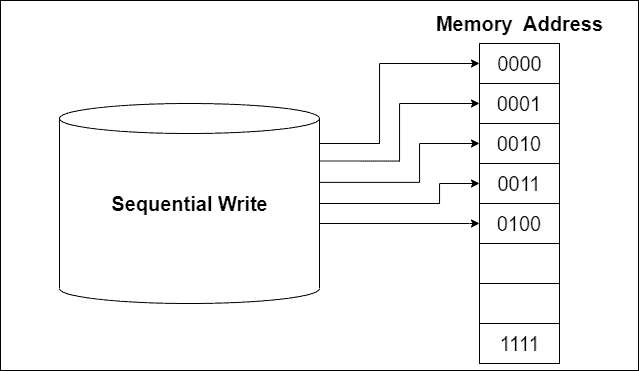
Sequential writes are fundamental to understanding how data is managed and stored, particularly in terms of performance and efficiency. Here are some characteristics of sequential writes:
- Contiguous Data Blocks: In sequential writes, data is written in adjacent blocks. For example, if you were to write a large file to a storage device, it would be written in one continuous stream, with each part of the file stored next to the previous part.
- Efficiency: Sequential writes are typically more efficient than random writes. This efficiency is due to the minimal movement required from the storage device’s read/write mechanism, whether it’s a spinning disk in a hard drive or an electronic controller in an SSD (Solid State Drive).
- Performance: The performance advantage of sequential writes is especially pronounced in traditional Hard Disk Drives (HDDs). Sequential writes allow the write head to stay in place while the disk spins, minimizing the time spent moving to different locations (seek time) and waiting for the disk to rotate to the correct position (rotational latency).
Sequential writes are commonly used in scenarios where large files are written to storage, such as video recording, transaction logs recording, and large files coping. In these cases, large continuous streams of data are written.
Introduction to Random Write
Unlike sequential writes that store data in a continuous and orderly sequence, random writes involve writing data to non-contiguous locations on the storage medium.
Random writes jump back and forth across the device sectors or blocks, creating a scattered data pattern with no clear starting point.
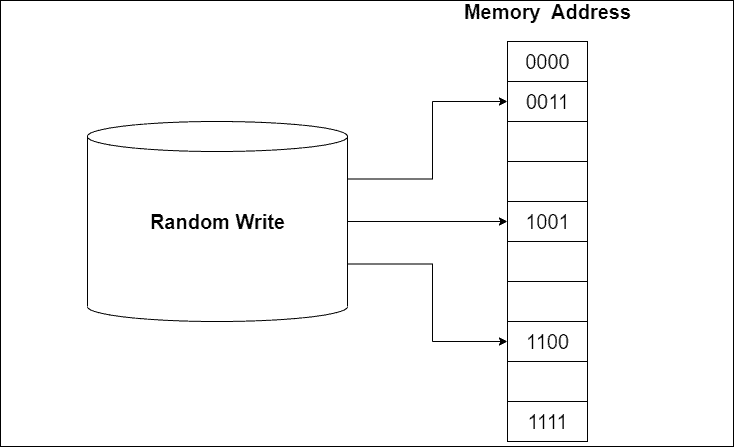
Random writes are characterized by their non-linear nature. When data is written randomly, the storage device must frequently locate the precise position on the disk where the data needs to be written. This operation disrupts the continuity of the write process, leading to increased latency and reduced throughput.
The impact of random write operations on performance is substantial both on Hard Disk Drives (HDDs) and Solid-State Drives (SSDs).
HDDs use spinning disks and a moving read/write head to store and retrieve data. In the case of random writes, the read/write head must continuously move to different locations on the disk to write data. This constant repositioning, known as Seek Time, combined with the time taken for the disk to rotate to the correct position (rotational latency), results in significant delays.
SSDs, which use NAND flash memory, handle random writes more efficiently than HDDs due to their lack of moving parts. However, random writes on SSDs still face challenges. Flash memory requires data to be written in blocks. If data needs to be updated or written randomly, the SSD must read the entire block, modify the specific portion, and then write the whole block back to memory.
Random write operations play a crucial role in the following cases:
- Operating Systems: Operating systems often perform random writes when processing system logs, paging files, and other small data writes.
- Databases: Databases typically need to update records and indexes frequently, involving a large number of random write operations.
- Virtual Machines: Running multiple virtual machines on a host can result in a large number of random writes as each virtual machine performs its own read and write operations.
Sequential vs Random Writes.
In the field of data storage and management, these two types of write operations significantly influence the performance and efficiency of storage devices. Analyzing sequential vs random writes is crucial for optimizing storage performance and making informed decisions about the appropriate storage technology for various workloads.
Here is a list highlighting the key differences between sequential writes and random writes across various aspects:
- Speed: Sequential writes are typically faster because data is written in a continuous and linear fashion. Random writes are slower because they require repositioning the write head (HDD) or performing the read-modify-write cycle (SSD) frequently.
- Latency: Sequential writes have lower latency because the write head (HDD) or controller (SSD) maintains a steady stream of data. Random writes have higher latency due to the time it takes to locate different write locations on the storage media.
- Impact on HDDs: Sequential writes are highly efficient, minimizing the seek time and spin delays. Random writes are inefficient due to the constant movement of the magnetic heads, resulting in significant performance degradation.
- Impact on SSDs: Sequential writes are faster, while random writes are slower due to the read-modify-write process, but the performance gap between the sequential and random writes is smaller compared to HDDs because of the lack of moving parts.
- Wear Leveling: Sequential writes tend to be more evenly distributed, reducing wear on a given storage unit (SSD). Random writes may result in uneven wear, which may shorten the life of the storage unit (SSD).
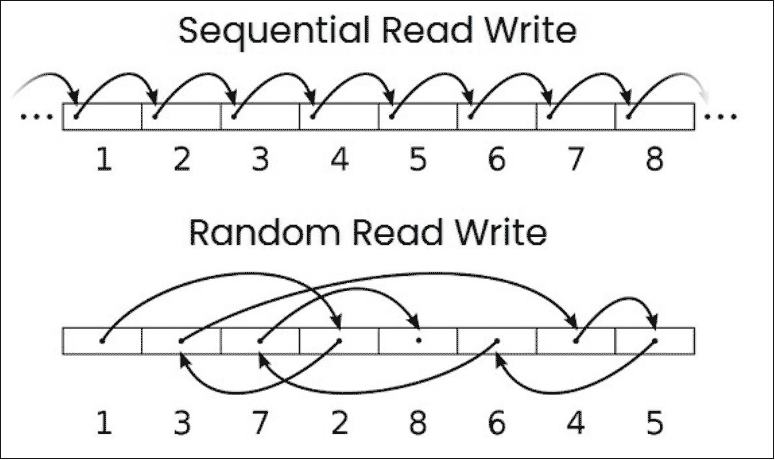
If you want to test the speed of your drives, you can use MiniTool Partition Wizard. With its various powerful features, you can recover hard drive data, clone hard drive, format FAT32, migrate OS, and do many more. It can also help you test the disk performance. Here is the guide:
MiniTool Partition Wizard FreeClick to Download100%Clean & Safe
Step 1: Launch MiniTool Partition Wizard and click Disk Benchmark on the tool bar.

Step 2: Select a drive, set parameters, and then click Start to test the disk performance.
The parameters are as follows:
- Select a drive: Computer users select a local disk or a volume to test its performance. The physical disk where the local disk is located will be listed afterwards.
- Transfer Size: It ranges from 1 KB to 2048 KB.
- Total Length: It ranges from 100 MB to 4096 MB.
- Queue Number: It ranges from 1 to 512.
- Thread Number: It ranges from 1 to 64.
- Test Mode: There are three modes for users to choose: Sequential, Random, and Sequential & Random.
- Cool Down Time: It is used to reduce the hard drive temperature before starting the next test.
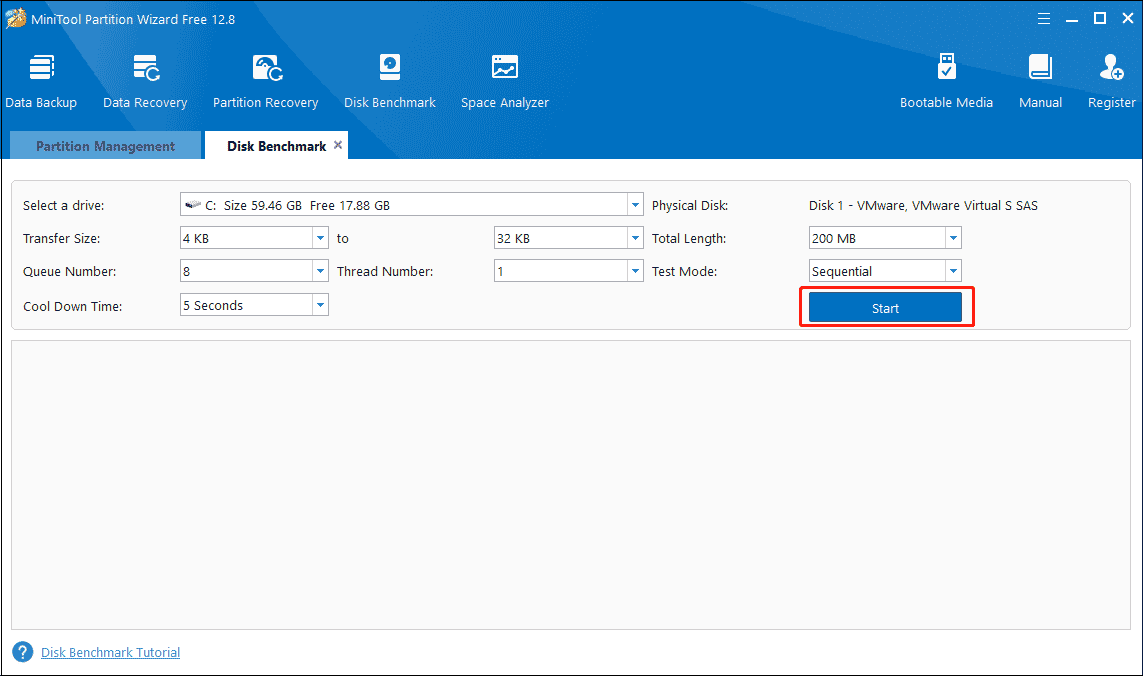
Bottom Line
This post explains the differences between sequential and random writes and can help users choose the right storage device. In addition, if you have any problems when using MiniTool Partition Wizard, you can contact us via the email [email protected]. Thanks in advance.

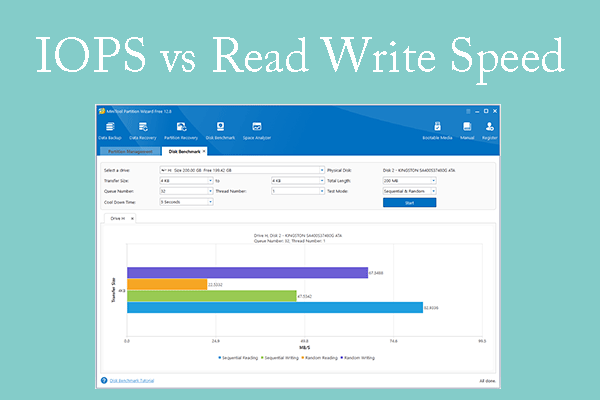
![How to Measure Disk Performance Easily [Step-By-Step Guide]](https://images.minitool.com/partitionwizard.com/images/uploads/2019/06/disk-performance-test-thumbnail.jpg)
User Comments :